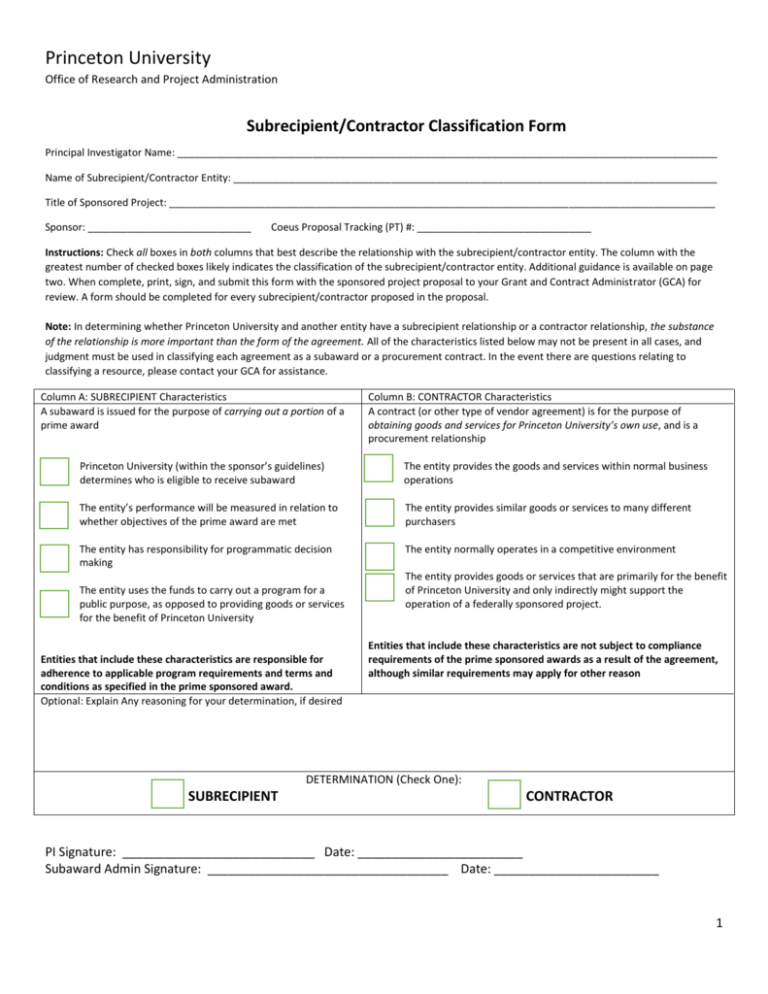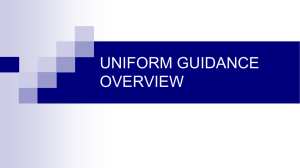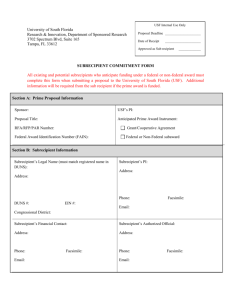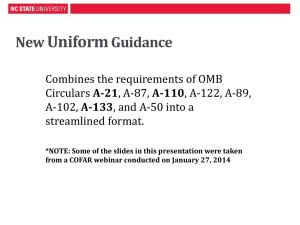Subrecipient/Contractor Classification Form
advertisement

Princeton University Office of Research and Project Administration Subrecipient/Contractor Classification Form Principal Investigator Name: ________________________________________________________________________________________________ Name of Subrecipient/Contractor Entity: ______________________________________________________________________________________ Title of Sponsored Project: _________________________________________________________________________________________________ Sponsor: _____________________________ Coeus Proposal Tracking (PT) #: _______________________________ Instructions: Check all boxes in both columns that best describe the relationship with the subrecipient/contractor entity. The column with the greatest number of checked boxes likely indicates the classification of the subrecipient/contractor entity. Additional guidance is available on page two. When complete, print, sign, and submit this form with the sponsored project proposal to your Grant and Contract Administrator (GCA) for review. A form should be completed for every subrecipient/contractor proposed in the proposal. Note: In determining whether Princeton University and another entity have a subrecipient relationship or a contractor relationship, the substance of the relationship is more important than the form of the agreement. All of the characteristics listed below may not be present in all cases, and judgment must be used in classifying each agreement as a subaward or a procurement contract. In the event there are questions relating to classifying a resource, please contact your GCA for assistance. Column A: SUBRECIPIENT Characteristics A subaward is issued for the purpose of carrying out a portion of a prime award Column B: CONTRACTOR Characteristics A contract (or other type of vendor agreement) is for the purpose of obtaining goods and services for Princeton University’s own use, and is a procurement relationship Princeton University (within the sponsor’s guidelines) determines who is eligible to receive subaward The entity provides the goods and services within normal business operations The entity’s performance will be measured in relation to whether objectives of the prime award are met The entity provides similar goods or services to many different purchasers The entity has responsibility for programmatic decision making The entity normally operates in a competitive environment The entity uses the funds to carry out a program for a public purpose, as opposed to providing goods or services for the benefit of Princeton University Entities that include these characteristics are responsible for adherence to applicable program requirements and terms and conditions as specified in the prime sponsored award. Optional: Explain Any reasoning for your determination, if desired The entity provides goods or services that are primarily for the benefit of Princeton University and only indirectly might support the operation of a federally sponsored project. Entities that include these characteristics are not subject to compliance requirements of the prime sponsored awards as a result of the agreement, although similar requirements may apply for other reason DETERMINATION (Check One): SUBRECIPIENT CONTRACTOR PI Signature: ____________________________ Date: ________________________ Subaward Admin Signature: ___________________________________ Date: ________________________ 1 Princeton University Office of Research and Project Administration Additional Guidance of Differentiating Between a Subrecipient and a Contractor Subrecipient The legal entity to which a subaward is made and which is accountable to the prime recipient for the use of the funds provided. An entity receiving a portion of the funds from a sponsored project is considered to be a subrecipient if it: Has programmatic involvement in the project identified by a separate scope of work, a separate budget and separate organization approval; Conducts substantive work (effort that engages directly in carrying out specific aims of the prime award); Has a director of the subaward who is considered the principal investigator (PI), and who may be considered a co-PI on the sponsored project with the PI at the prime institution; Has responsibility for the programmatic decision-making; Has responsibility for adherence to applicable program compliance requirements (i.e. IRB/IACUC approvals, FCOI policies, etc.); Uses the sponsored funds to carry out the project at its institution as compared to providing goods or services for the project at Princeton University; Has the right to publish project results or serve as a co-author; and/or Has potentially patentable or copyrightable technology and intellectual property (IP) resulting from the project. Subawards are processed through the Office of Research and Project Administration (ORPA). For more information, go to http://www.princeton.edu/ORPA Type of Contractors Consultant An individual or company receiving a portion of the funds from the sponsored project is considered a consultant if he/she/it: Is an expert advisor; Is paid for time spent on a fixed hourly/daily basis, which includes travel expenses, supplies, etc.; Is using his/her/its own equipment and materials, not equipment or materials from his/her/its institution for the work on the project; Is providing services that are specialized, highly technical, and commercially available; Is considered to be paid a “fee for service” whose work and IP belong to Princeton University; Pays his/her/its own taxes on earning from the project; Is not employed by Princeton University in any other capacity; and/or Is not involved in Programmatic work on the project; including project deliverables such as reports. *Note – Consultants may be considered Non-key Personnel, Other Significant Contributors, or, rarely, Key Personnel on a sponsored project. PIs must carefully review the role of the consultant to make this determination. Vendor/Service Provider An individual or company receiving a portion of the funds from a grant award is considered a vendor if he/she/it: Provides goods and/or services ancillary to the project; Is paid a flat fee; Provides similar goods or services to many different customers; and/or Is not involved in programmatic work on the project, including project deliverables such as reports. Consultants and Vendors/Service Providers are processed through the Purchasing Departing. For more information, go to https://contracting.princeton.edu/contracting/purchasing-transactions/ 2








